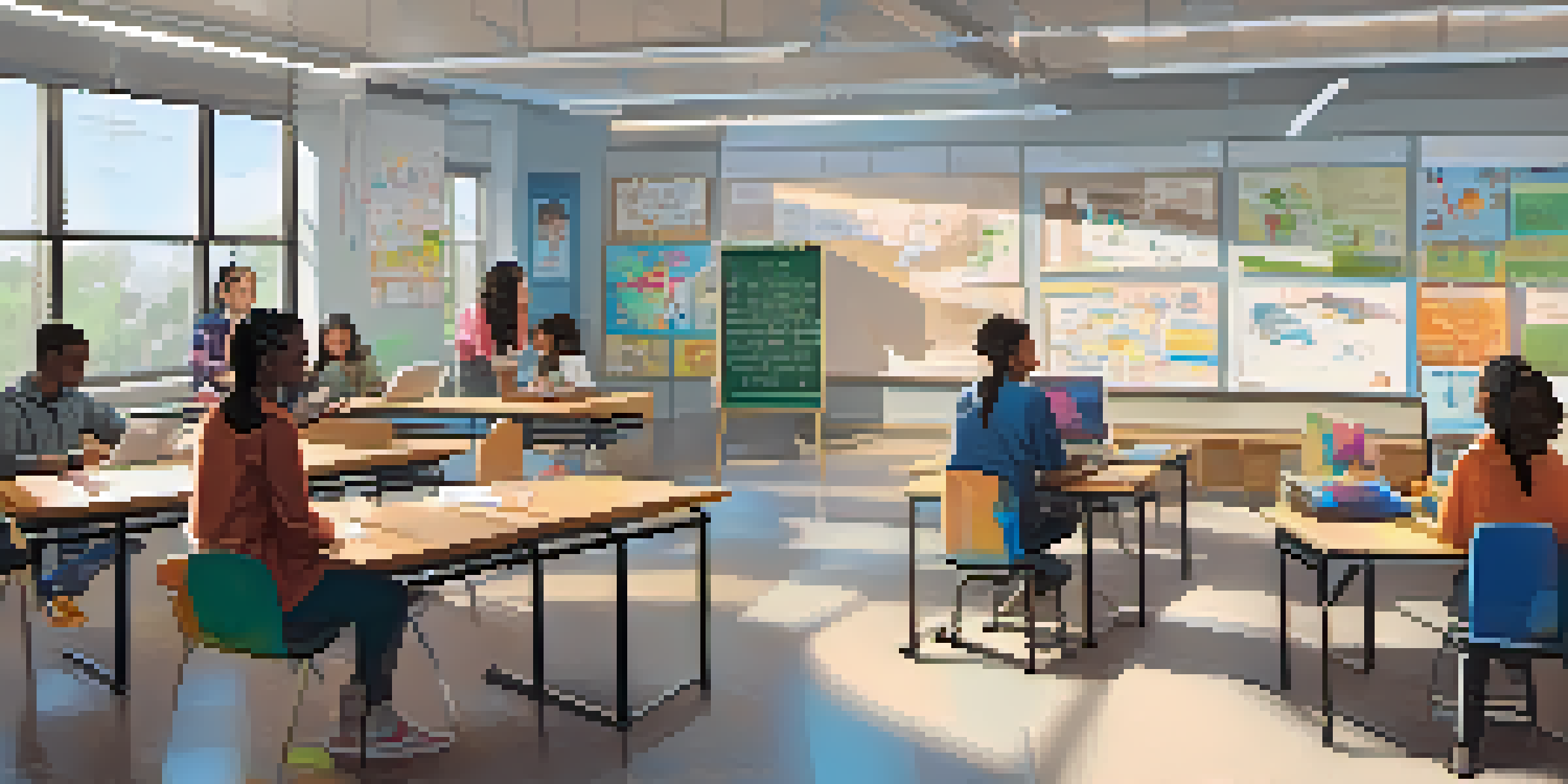Frameworks for Effective Integration of Online and In-Person Learning

Understanding the Need for Integrated Learning Frameworks
In today's educational landscape, the blending of online and in-person learning is more crucial than ever. With the rise of digital technology and the recent global challenges, learners expect flexibility and accessibility in their education. An integrated learning framework helps institutions meet these demands while enhancing the learning experience.
Education is not the filling of a pail, but the lighting of a fire.
These frameworks provide a structured approach, ensuring that both online and offline elements complement each other. For instance, students might engage in online discussions to prepare for in-person workshops, fostering a deeper understanding of the material. The goal is to create a seamless transition between learning environments.
By recognizing the unique strengths of each mode, educators can design experiences that maximize engagement. Online platforms can offer diverse resources and interactive content, while in-person sessions allow for hands-on activities and personal connections. This synergy ultimately leads to more effective learning outcomes.
Key Components of Effective Integration Frameworks
Effective integration frameworks typically include several key components that work together harmoniously. First and foremost is curriculum alignment, ensuring that online and in-person lessons are interconnected and build upon each other. This means that every online module should prepare students for what they will experience in the classroom.

Another essential component is technology support. Utilizing user-friendly platforms that facilitate communication and collaboration can make a world of difference. For example, learning management systems (LMS) can track progress, host discussions, and house resources, creating a centralized hub for students and instructors alike.
Integrated Learning Enhances Flexibility
An integrated learning framework combines online and in-person education, offering students the flexibility and accessibility they expect.
Lastly, the importance of assessment methods cannot be overlooked. Integrating assessments that evaluate both online participation and in-person performance encourages students to engage fully in both environments. By providing a holistic view of student progress, educators can better tailor their teaching strategies to meet individual needs.
Creating a Supportive Learning Environment
A supportive learning environment is pivotal for the success of an integrated framework. This involves fostering a culture of collaboration, where students feel comfortable participating both online and in person. Encouraging open communication and providing avenues for feedback can help build this sense of community.
The great aim of education is not knowledge but action.
Additionally, training educators to effectively facilitate in both learning modes is crucial. Professional development opportunities can equip instructors with strategies to engage students in various settings. For instance, training in digital tools can empower teachers to utilize technology effectively during in-person classes, enhancing the overall experience.
Moreover, ensuring that resources are accessible to all students is vital. This includes providing technical support and creating alternative formats for materials. A learning environment that prioritizes inclusivity allows every student to thrive, regardless of their preferred learning style.
Engaging Students Through Interactive Content
Engagement is key to successful learning, and interactive content plays a significant role in achieving this. Online platforms offer a plethora of tools such as quizzes, polls, and discussion forums that can captivate students’ attention. When students actively participate in their learning, retention and understanding improve dramatically.
In-person sessions can further enhance engagement by incorporating hands-on activities and group discussions. For example, after completing an online module, students might engage in a group project that applies what they’ve learned in real-world scenarios. This not only reinforces knowledge but also builds critical thinking and teamwork skills.
Engagement is Key to Learning Success
Interactive content in both online and in-person settings boosts student engagement, leading to improved retention and understanding.
Blending these interactive elements across both formats creates a dynamic learning experience. When students see the connection between their online activities and in-person applications, they are more likely to remain motivated and invested in their education.
Utilizing Data to Inform Instruction
Data plays an essential role in refining integrated learning frameworks. By analyzing student performance, educators can gain insights into what’s working and what needs improvement. For example, tracking online engagement metrics can help identify students who may require additional support in upcoming in-person sessions.
Furthermore, feedback from both students and educators can provide valuable information on the effectiveness of the integration. Surveys and discussions can highlight areas where students feel connected or disconnected between modes. This feedback loop is crucial for continuous improvement in teaching strategies.
Ultimately, the goal is to use data to create a responsive learning environment. By being proactive and making adjustments based on real-time information, educators can ensure that all students are receiving the best possible experience, whether online or in person.
Challenges in Integrating Learning Approaches
While there are many benefits to integrated learning frameworks, challenges do exist. One significant hurdle is the potential for technological issues, which can disrupt the learning process. Institutions must ensure that both educators and students have access to reliable technology and support to mitigate these disruptions.
Another challenge is the varying levels of comfort with technology among students and educators. Some may thrive in online environments, while others may struggle. Providing training and resources is essential to help everyone feel confident in using digital tools effectively.
Data-Driven Instruction Improves Outcomes
Utilizing data to inform instruction allows educators to adjust teaching strategies based on student performance and feedback.
Lastly, time constraints can hinder the implementation of integrated frameworks. Educators often juggle multiple responsibilities, making it difficult to design and execute cohesive lessons. Institutions that prioritize planning and collaboration time for teachers can help alleviate this issue, fostering a more robust integration of learning approaches.
Future Trends in Integrated Learning
As technology continues to evolve, so too will the methods for integrating online and in-person learning. Emerging trends such as artificial intelligence (AI) and personalized learning experiences are set to change the landscape significantly. These innovations can help tailor educational experiences to meet individual student needs more effectively.
Moreover, the rise of hybrid learning models is likely to persist, as many students appreciate the flexibility they offer. Educational institutions may need to adapt their frameworks to accommodate this shift, ensuring that both online and in-person experiences are equally valuable.

Lastly, collaboration among educational institutions, technology providers, and educators will be essential in shaping the future of integrated learning. By sharing best practices and resources, the education sector can continue to innovate and improve, ultimately benefiting students and enhancing their learning journey.